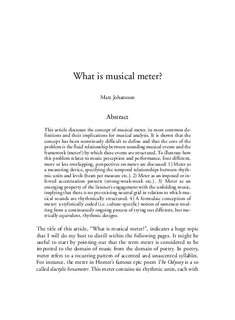What is musical meter?
Journal article, Peer reviewed
Published version
Permanent lenke
http://hdl.handle.net/11250/2438135Utgivelsesdato
2010Metadata
Vis full innførselSamlinger
Originalversjon
Musikk og tradisjon 2010 (24) s. 41-59Sammendrag
This article discusses the concept of musical meter, its most common definitions and their implications for musical analysis. It is shown that the concept has been notoriously difficult to define and that the core of the problem is the fluid relationship between sounding musical events and the framework (meter?) by which these events are structured. To illustrate how this problem relates to music perception and performance, four different, more or less overlapping, perspectives on meter are discussed: 1) Meter as a measuring device, specifying the temporal relationships between rhythmic units and levels (beats per measure etc.). 2) Meter as an imposed or inferred accentuation pattern (strong-weak-weak etc.). 3) Meter as an emerging property of the listener's engagement with the unfolding music, implying that there is no pre-existing neutral grid in relation to which musical sounds are rhythmically structured. 4) A formulaic conception of meter: a stylistically coded (i.e. culture-specific) notion of sameness resulting from a continuously ongoing process of trying out different, but metrically equivalent, rhythmic designs.
